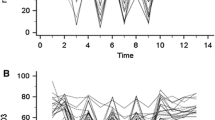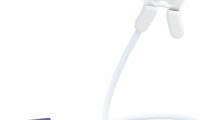Abstract
Objective
This study compared the performance of forehead reflectance and conventional pulse oximetry (SpO2) in mechanically ventilated, anesthetized patients undergoing major abdominal surgery with either laparoscopic or laparotomic techniques.
Methods
SpO2 was continuously measured both with a forehead reflectance and a conventional digit sensor in 20 ASA physical status I–III, anesthetized patients undergoing either a laparotomic (group Laparotomy, n = 10) or laparoscopic (group Laparoscopy, n = 10) major abdominal surgery. SpO2 values measured with the two sensors were continuously recorded at 10-second intervals during the entire procedure, and then analyzed for consistency.
Results
In group Laparotomy finger and forehead readings remained consistently similar during the study period; on the contrary, in group Laparoscopy forehead SpO2 readings showed a much wider variability. The mean (95% Confidence Intervals) difference between finger and forehead SpO2 readings was 2.0% (−1.3% to +6.0%) in group Laparotomy and 2.5% (−3.5% to +8.4%) in group Laparoscopy (p = 0.001); however, in group Laparoscopy the mean difference between digit and forehead SpO2 values increased from 0.2% (CI95: −2.1% to +2.5%) during the first hour to 4.5% (CI95: −2.5% to +11–5%) in the second hour (p = 0.0005), and 3.1% (CI95: −2.4% to + 8.6%) in the third hour of surgery (p = 0.0005). Clinically relevant desaturation (decrease of SpO2 < 89% for ≥30 s) detected with the forehead sensor in the Laparoscopy group was significantly more frequent and longer lasting than with conventional digit sensor. No differences were observed in group Laparotomy.
Conclusions
Forehead reflectance oximetry is as accurate as conventional digit based oximetry in mechanically ventilated patients undergoing laparotomic surgery in the supine position, but is significantly influenced by patient positioning and pneumoperitoneum during laparoscopic surgery.
Similar content being viewed by others
References
Eichhorn JH, Cooper JB, Cullen DJ, Maier WR, Philip JH, Seeman RG (1986) Standards for patient monitoring during anesthesia at Harvard Medical School. JAMA 256: 1017–1020
Louw A Van de, Cracco C, Cerf C, Harf A, Duvaldestin P, Lemaire F, Brochard L (2001) Accuracy of pulse oximetry in the intensive care unit. Intensive Care Med 27: 1606–1613
Barker SJ, Shah NK (1997) The effects of motion on the performance of pulse oximeters in volunteers. Anesthesiology 86: 101–108
Trivedi NS, Ghouri AF, Shah NK, Lai E, Barker SJ (1997) Effects of motion, ambient light, and hypoperfusion on pulse oximeter function. J Clin Anesth 9: 179–183
Gehring H, Hornberger C, Matz H, Konecny E, Schmucker P (2002) The effects of motion artifact and low perfusion on the performance of a new generation of pulse oximeters in volunteers undergoing hypoxemia. Respir Care 47: 48–60
Hertzman AB, Roth LW (1942) The absence of vasoconstrictor reflexes in the forehead circulation: effects of cold. Am J Physiol 136: 6092–6097
MacLeod DB, Cortinez LI, Keifer JC, Cameron D, Wright DR, White WD et al (2005) The desaturation response time of finger pulse oximeters during mild hypothermia. Anaesthesia 60: 65–71
Berkenbosch JW, Tobias JD (2006) Comparison of a new forehead reflectance pulse oximeter sensor with a conventional digit sensor in pediatric patients. Respir Care 51: 726–731
Hummler HD, Engelmann A, Pohland F, Hogel J, Franz AR (2004) Accuracy of pulse oximetry readings in an animal model of low perfusion caused by emerging pneumonia and sepsis. Intensive Care Med 30: 709–713
Cheng EY, Hopwood MB, Kay J (1988) Forehead pulse oximetry compared with finger pulse oximetry and arterial blood gas measurement. J Clin Monit 4: 223–226
Jorgensen JS, Schmid ER, Konig V, Faisst K, Huch A, Huch R (1995) Limitations of forehead pulse oximetry. J Clin Monit 11: 253–256
Mannheimer PD, Bebout DE (2002) The OxiMax System. Nellcor’s new platform for pulse oximetry. Minerva Anestesiol 68: 236–239
Kurki TS, Piirainen HI, Kuriki PT (1990) Non-invasive monitoring of finger arterial pressure in patients with Raynaud’s phenomenon: effects of exposure to cold. Br J Anaesth 65: 552–563
Branson RD, Mannheimer PD (2004) Forehead oximetry in critically ill patients: the case for a new monitoring site. Respir Care Clin N Am 10: 359–367
Hummler HD, Pohlandt F, Franz AR (2002) Pulse oximetry during low perfusion caused by emerging pneumonia and sepsis in rabbits. Crit Care Med 30: 2501–2508
Shelley KH, Tamai D, Jablonka D, Gesquiere M, Stout R, Silverman DG (2005) The effect of venous pulsation on the forehead pulse oximeter wave form as a possible source of error in SpO2 calculation. Anesth Analg 100: 743–747
Dassel AC, Graaf R, Sikkema M, Mejer A, Zijlstra WG, Aarnoudse JC (1995) Reflectance pulse oximetry at the forehead improves by pressure on the probe. J Clin Monit 11: 237–244
Hofer CK, Zalunardo MP, Klaghofer R, Spahr T, Pasch T, Zollinger A (2002) Changes in intrathoracic blood volume associated with pneumoperitoneum and positioning. Acta Anaesthesiol Scand 46: 303–308
Tugrul M, Camci E, Pembeci K, Al-Darsani A, Telci L (2004) Relationship between peripheral and central venous pressures in different patient positions, catheter sizes, and insertion sites. J Cardiothorac Vasc Anesth 18: 446–450
Agashe GS, Coakley J, Mannheimer PD (2006) Forehead pulse oximetry. Headband use helps alleviate false low readings likely related to venous pulsation artefacts. Anesthesiology 105: 1111–1116
Acknowledgements
The study was entirely supported by the University of Parma and Azienda Ospedaliera di Parma. The Authors thank Tyco Healthcare, Milano, Italy for supplying the Score Analysis Software and both forehead and digit sensors free of charge.
Author information
Authors and Affiliations
Corresponding author
Additional information
Casati A, Squicciarini G, Baciarello M, Putzu M, Salvadori A, Fanelli G.Forehead reflectance oximetry: A clinical comparison with conventional digit sensors during laparotomic and laparoscopic abdominal surgery.
Rights and permissions
About this article
Cite this article
Casati, A., Squicciarini, G., Baciarello, M. et al. Forehead Reflectance Oximetry: A Clinical Comparison with Conventional Digit Sensors during Laparotomic and Laparoscopic Abdominal Surgery. J Clin Monit Comput 21, 271–276 (2007). https://doi.org/10.1007/s10877-007-9084-x
Received:
Accepted:
Published:
Issue Date:
DOI: https://doi.org/10.1007/s10877-007-9084-x




